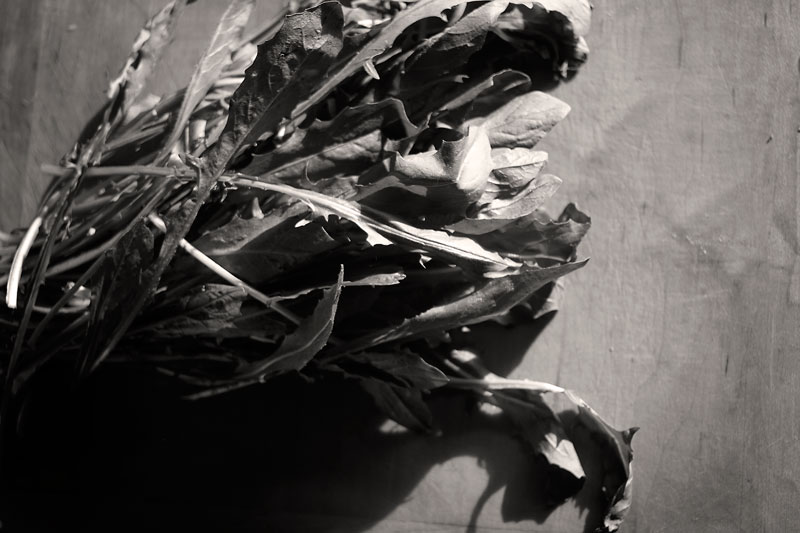Lyndall “Granny” Toothman grew up in Appalachia. Her family didn’t have a lot of money. She remembers Christmas dinners as a child when everyone dined on fresh greens without the help of refrigeration, a supermarket, or a greenhouse.
In the fall, about October when things died down, we would get dandelion roots and put them in a box that had a little soil in the bottom so the roots could adhere. Then we’d go out in the woods and pull the leaves aside and get that soft rich wood pummy soil and put about eight to ten inches of that over the top of those roots, and put that box down in the cellar in a dark place. About a month before Christmas, we’d bring that box out and put it in a nice warm sunny window and begin watering those roots, and they’d shoot up through that pummy soil. The reason for having it so deep is that you want the dandelion leaves to be as long as you can get them. They come up yellow until they get out of the soil into the light, and then they turn green, but what you want mostly is those yellow leaves, and the longer they are, the more tender they are. We liked them in six- to eight-inch yellow spikes with little tips of green at the top.
…
If we didn’t pull the whole plant to get the leaves, we’d let the roots stay in that box and keep sprouting them and we’d have several messes after Christmas.
That was a long time ago. You may have seen an odd recipe calling for dandelion greens, or spotted some hopeful farmer selling them from her tent at market. But by and large dandelions are still the scourge of most lawns.
Today Granny would be praised by a small but rapidly growing “locavore”-foodie culture. But the most interesting thing about Granny is not her “commitment” to eating locally, or to weird food, or even her thrift. It’s her fondness for those greens. She remembers how long the leaves needed to be. She is clear about the right kind of soil. And she adds the exciting afterthought of the “several messes” after Christmas. Messes of dandelion leaves.
Greens at contemporary holiday meals are far more mild, or crunchy, or – whatever we like! But what do we remember about our meals? What is there to remember?
Perhaps the reason Granny remembers her Christmas greens with such clarity (“six- to eight inches”) is because she participated in a work that brought those greens to the table, and that work required effort, gentleness, skill, thought, patience – planning – and very likely some degree of wonder. In other words, her involvement in that meal required not only her appetite, which is critical, but also much of her being.
Loren Wilkinson once suggested to me that perhaps the thing that separates humans from other creatures is that while animals feed, we humans feast. In other words, we are not only what we eat (if food is fuel, what are we?), but also how we eat.
When all that our food asks of us is our money and an ability to mix the contents of a box with hot water, then the quality of that meal is matched by the quality of our lives – forgettable, bland, utilitarian. But if we attend to food with our whole selves, we might find ourselves becoming a little bit more whole, more human, more like Granny.
Granny’s Bitter Greens
Ingredients
- A mess of bitter greens chopped, a list: dandelion leaves, arugula, collards, bok choy, kale, mustard, Chinese cabbage, broc
- 1/3 cup apple cider vinegar
- 1/2 cup water
- 1 tsp salt
- 1 tbsp Sugar a “good” tablespoon
- 1 tsp Salt
- 3 tbsp grease from animal fat, preferably ham, or bacon,
Directions
- Mix this together till the sugar’s dissolved, add to hot skillet with animal fat. Yes, nearly everything is made delicious with bacon grease, but almost anyone who has grown up on some variation of this recipe – where greens and fat meet — will tell you that the grease actually enhances the greens.
- While still hot, pour it all over the greens.
- Optional: top with chopped green onions.







